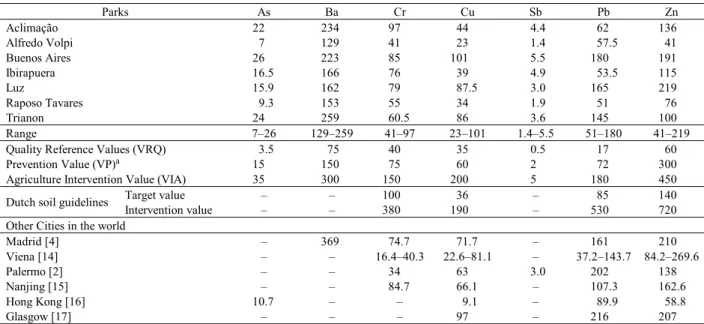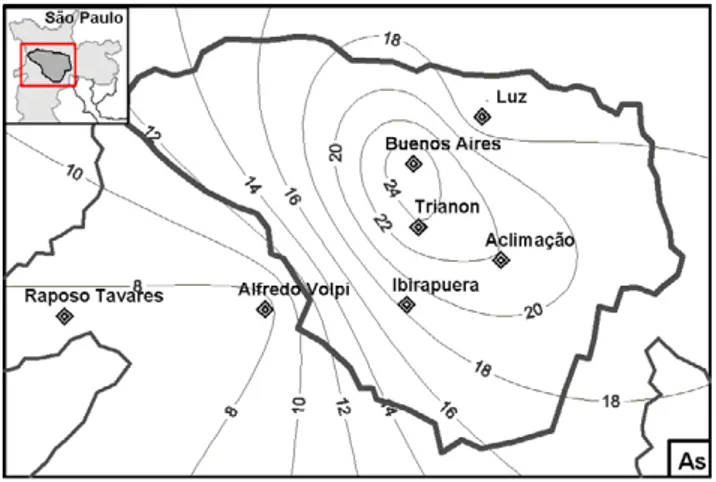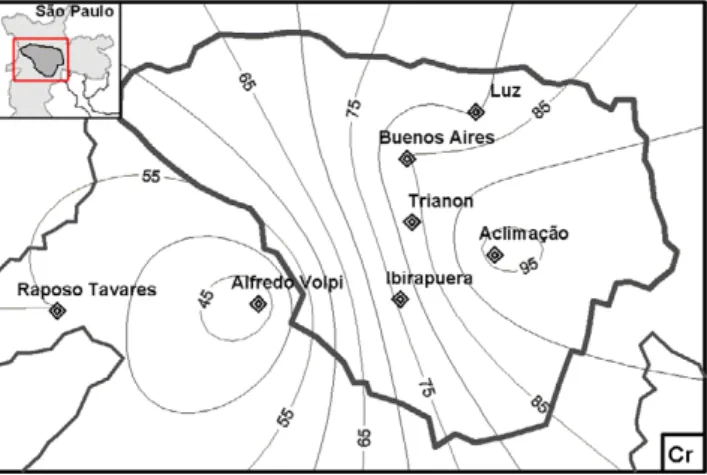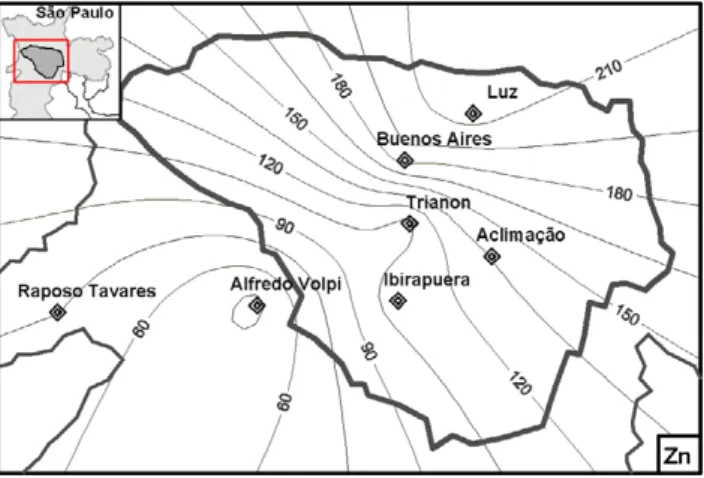Metal contamination in urban park soils of São Paulo
A. M. G. Figueiredo,1* J. Enzweiler,2 S. P. Camargo,1 J. B. Sígolo,3 F. C. Gumiero,1 A. C. Pavese,1 F. M. Milian4
1 Instituto de Pesquisas Energéticas e Nucleares (IPEN/CNEN - SP), Av. Professor Lineu Prestes 2242, 05508-000, São Paulo, SP, Brazil 2 Instituto de Geociências – UNICAMP, C.P. 6152, 13083-970 Campinas, SP, Brazil
3 Instituto de Geociências – USP, Rua do Lago 562, 05508-080 São Paulo, SP, Brazil
4 Universidade Estadual de Santa Cruz – UESC, km 16, Rod. Ilhéus-Itabuna, 45650-000 Ilhéus, BA, Brazil (Received February 17, 2009)
There has been little research on metal concentration levels in urban soils of São Paulo, a city with 19 million inhabitants with severe pollution problems. In the present study, the concentration of As, Ba, Cr, Cu, Pb, Sb and Zn, were determined by INAA and XRFin surface soil samples from 7 public parks located within São Paulo city. The results obtained showed that soils of São Paulo public parks present concentration levels of the studied elements higher than the reference values for soils in São Paulo State. Traffic related elements such as Cu, Pb and Zn presented high concentrations in parks located near avenues of highly dense traffic and may be associated to vehicular sources.
Introduction
The urban environment quality is of vital importance as most of people now live in cities. Human health in
cities is strongly dependent on the status of urban soils.1
Urban soils are known to have peculiar characteristics such as unpredictable layering, poor structure and high
concentrations of trace elements.2
In recent years urban soils have received increased attention by scientists, leading to studies focused on their description and investigation all over the world, due to the increasing metal pollution derived from incinerators, industrial waste, atmospheric deposition of
dust and aerosols, and other activities.1–7 Urban soils
play an important role in maintaining the environmental quality as they can act as both source and sink for
pollutants that can affect human health.6 In areas where
public gardens and parks are exposed to significant pollution levels, dust from the ground has toxic effects as a consequence of inhalation or ingestion by humans, particularly children who are more susceptible to the adverse effects of soil ingestion than adults due to their
developing nervous system and high absorption rate.2,7
Contaminated urban soils have been identified by several authors as a significant source of Pb exposure in
children.7,9 In a study with 2-year-old children carried
out in the UK, it was found that ingestion of dust as a result of hand-to-mouth activity accounted for 50% of a child's Pb intake.9
There has been little research on urban soils in São Paulo, the biggest city in Latin America. The metropolitan region of São Paulo has a population of 19 million people and a strong industrial activity. The urban area is polluted by industrial emissions but, according to the Environmental Protection Agency of the State of São
Paulo, CETESB,10 the governmental agency of air
quality control, emissions from about 7.8 million motor vehicles daily are the main sources of air pollution. Serious environmental and health problems have especially been observed in the region due to particulate
materials (PM10) with varied composition.11 São Paulo
city has suffered a rapid and disordered growth in the last decades which has led to considerable loss in agricultural soils and urban green space. Therefore, São Paulo public parks play an important role as leisure areas for the population. This study presents the results of a project which aims to generally assess the concentration data for 7 potentially toxic elements (As, Ba, Cr, Cu, Pb, Sb and Zn) in public park soils of São Paulo. In order to highlight the extent and severity of the contamination, we take advantage of the availability of a dataset provided by CETESB of reference values for
soils of São Paulo.10
Experimental Study area
Seven public parks of São Paulo were studied: Aclimação, Alfredo Volpi, Buenos Aires, Ibirapuera, Luz, Raposo Tavares and Tenente Siqueira Campos (Trianon) Parks. The Alfredo Volpi Park was part of an old tea farm and still preserves a significant portion of the Atlantic Forest vegetation. The Aclimação Park is located at the central region of the city, in a residential area. The Buenos Aires, Luz and Trianon Parks are located in the central region of the city, surrounded by avenues with high traffic density. The Ibirapuera Park, located in the southern region of the city, is by far one of the biggest and most visited parks of the city of São Paulo, receiving more than 400,000 visitors during the weekends. The Raposo Tavares Park differs in relation to the other parks in that it was the first in
South America built over a municipal landfill site for urban waste disposal. Its soil consists of a mixture of garbage and soil covered by a clay layer to lower gas emissions.
Materials and sampling strategy
The soil samples were collected between October 2006 and April 2007. Top soil samples (0–5 cm) were composed by sub-samples collected in lines across the park every 10 m. Sampling was performed in order to have representative samples of the entire park, mainly in sites where the flux of people was more intense, such as jogging paths, playgrounds and sport and leisure areas. A polyethylene tube with 4 cm diameter was used to take the samples, which were stored in inert plastic bags. In the laboratory, the samples were dried at 40–50 °C and were sieved through plastic-only sieves into <2 mm fractions. Before and after sieving, the samples were homogenized and quartered. Samples were then ground using an agate mortar in order to obtain a fine and homogeneous powder (<75 mm).
Analytical methods
Instrumental Neutron Activation Analysis (INAA) and X-ray Fluorescence (XRF) were used for metal analysis.
Instrumental neutron activation analysis (INAA) was employed to analyse As, Ba, Cr, Sb and Zn. One hundred to one hundred and fifty mg of each sample and of the geological reference materials basalt BE-N (ANRT) and granite GS-N (ANRT), used as standards, were accurately weighed in polyethylene bags. Samples and reference materials were irradiated for 8 hours at a
thermal neutron flux of 1013 cm–2.s–1 at the IEA-R1
nuclear reactor of IPEN. The measurements of the induced gamma-ray activity were carried out in a gamma-ray spectrometer with a GX20190 hyperpure Ge detector (Canberra). The accuracy and precision of the results were verified by the analysis of the reference material Soil-7 (IAEA). The results showed good accuracy (relative deviations to certified values <5% for most of the elements) and good precision (relative standard deviations <15%).
X-ray florescence (XRF) was employed to determine Pb and Cu. Pellets (40 mm diameter) consisting of a mixture of 9 g of the sample and 1.5 g of powdered wax (Hoechst) were prepared and measured in a sequential XRF spectrometer (PW2404, Philips), equipped with a rhodium tube. The accuracy and precision of the results were verified by the analysis of the reference materials GSS-2 and GSS-4, presenting relative errors and precision better than 10%.
Results and discussion
Table 1 presents the mean values obtained for the analysed elements in the park soils, as well as the reference values for soils in São Paulo of the Environmental Protection Agency of the State of São
Paulo (CETESB) guidelines.10 The Quality Reference
Value (VRQ) is the concentration of a substance in the soil or groundwater which defines groundwater quality and clean soil. It is determined considering statistical interpretation of physico-chemical analysis of different kinds of soils from São Paulo State. The Prevention Value (VP) is the concentration limit of a substance that causes no damage to soil and groundwater quality until this limit. This level indicates a soil capable to maintain its primary functions, protecting the ecological receptors and the groundwater quality. It was determined based on ecological receptors assays. The Agriculture Intervention Value APMax (VIA) is the concentration of a substance in the soil or groundwater above which there are direct or indirect potential risks to human health. For soil, this was calculated by using human health risk assessment procedures for agriculture exposition
(Maximum Protection Area – APMax).10 These values
are the available reference values for São Paulo soils. Nevertheless, it should be pointed out that INAA and XRF provide the total metal concentration, as the samples are not submitted to a chemical attack. CETESB guideline values were based on concentration values obtained by wet analysis, which may account for differences in the results.
Table 1 shows that all the presented element concentration levels are above the VRQ. Except for Zn, all the presented element levels are above VP mostly in Buenos Aires, Trianon and Luz Parks. Lower concentrations were observed in Alfredo Volpi Park, which may indicate less anthropogenic influence in this park, due to its history and location. The Raposo Tavares Park, built over a landfill did not present high concentrations of the analyzed elements.
In the case of Pb, in Buenos Aires Park, the concentration of 180 mg/kg is equal to the VIA, which may indicate potential risks to human health. The Pb levels in Luz, Trianon and Buenos Aires Parks exceeded
the target value reported by the Dutch Soil Guidelines.5
Zn and Cu concentrations in Luz and Buenos Aires Parks are higher than the target value reported by the same guidelines. These elements (Cu, Pb and Zn) have
been considered to be traffic related ones.5 Another
traffic related element is Sb. Except in Alfredo Volpi and Raposo Tavares Parks, this element presented higher values than the VP values. In the Buenos Aires Park, the values were even higher than the VIA.
In the case of As, higher levels than the VIA ones were observed in Aclimação, Buenos Aires, Ibirapuera, Luz and Trianon Parks. According to the Preliminary
Remediation Goals (PRGs) from EPA,12 As levels of
4.5 mg/kg may cause cancer risk of one per million through dermal absorption. Cr levels were between VRQ and VP, except in Alfredo Volpi and Raposo Tavares Parks, where they were similar to the VRQ.
Literature values of similar studies in other big cities and international guideline values are also reported in Table 1, for comparison. As can be seen the
concentration values found in São Paulo park’s soil are similar to those reported for other cities in the world. It should be noted that tropical and temperate soils have particular characteristics which can cause significant differences in metal concentrations.
For a better overview of the data, the metal concentration variations in the parks were plotted (Fig. 1). The Sb concentration was multiplied by 10 to improve the visualization of the data. Distribution maps for the analyzed elements were drawn up using Surfer 8 software and are presented in Figures 2 to 8.
Table 1. Topsoil metal concentration in Public Parks of São Paulo (mg.kg–1)
Parks As Ba Cr Cu Sb Pb Zn Aclimação 22 234 97 44 4.4 62 136 Alfredo Volpi 7 129 41 23 1.4 57.5 41 Buenos Aires 26 223 85 101 5.5 180 191 Ibirapuera 16.5 166 76 39 4.9 53.5 115 Luz 15.9 162 79 87.5 3.0 165 219 Raposo Tavares 9.3 153 55 34 1.9 51 76 Trianon 24 259 60.5 86 3.6 145 100 Range 7–26 129–259 41–97 23–101 1.4–5.5 51–180 41–219
Quality Reference Values (VRQ) 3.5 75 40 35 0.5 17 60
Prevention Value (VP)a 15 150 75 60 2 72 300
Agriculture Intervention Value (VIA) 35 300 150 200 5 180 450
Target value – – 100 36 – 85 140
Dutch soil guidelines
Intervention value – – 380 190 – 530 720
Other Cities in the world
Madrid [4] – 369 74.7 71.7 – 161 210 Viena [14] – – 16.4–40.3 22.6–81.1 – 37.2–143.7 84.2–269.6 Palermo [2] – – 34 63 3.0 202 138 Nanjing [15] – – 84.7 66.1 – 107.3 162.6 Hong Kong [16] 10.7 – – 9.1 – 89.9 58.8 Glasgow [17] – – – 97 – 216 207
Fig. 2. Distribution map of As in public parks of São Paulo (mg.kg–1)
Fig. 3. Distribution map of Ba in public parks of São Paulo (mg.kg–1)
Fig. 4. Distribution map of Cr in public parks of São Paulo (mg.kg–1)
As shown, the highest metal concentrations of all elements, mainly As, Ba, Cu, Pb and Zn, were obtained
density traffic avenues (Fig. 1). Zn and Cu are traffic-related elements and may be associated to vehicular
tear of certain automobile materials and parts during
driving.13 This may indicate that the source of these
elements are vehicular emissions, since these parks are located in regions with saturated traffic flow.
For Pb, there was clear evidence of higher concentrations in Buenos Aires, Luz and Trianon Parks
in relation to the others. This is an extremely interesting result, since Pb is not expected to be traffic related nowadays, because lead-free gasoline in Brazil has been available since 1983. However, there are still many old cars in São Paulo’s fleet which may contribute to lead emissions.
Fig. 5. Distribution map of Cu in public parks of São Paulo (mg.kg–1)
Lead is well known to be one of the less mobile elements in soils, which could explain the high values still found in these parks, since Luz and Buenos Aires Parks are the oldest parks in the city (Luz Park was created in 1825 and was the city’s first public garden; Trianon was inaugurated in 1892).
On the other hand, Alfredo Volpi Park soils presented the lowest concentration of all elements. This park is located in one of the most preserved areas of São Paulo city, indicating background concentrations of the analyzed elements in its soils.
Chromium was spread along the region showing that its source is not evident and that Cr can be associated either to natural and anthropogenic sources (Fig. 4). As and Sb did not show any particular tendency in their distribution pattern and thus it was not possible to identify a specific source from these results (Figs 2 and 7).
A cluster analysis by using the Statistica software was performed and the dendrogram obtained from the data is shown in Fig. 9.
Fig. 8. Distribution map of Zn in public parks of São Paulo (mg.kg–1)
Fig. 9. Dendrogram obtained for the studied parks
It can be seen that there are three main groups, one represented by the Aclimação, Ibirapuera and Trianon Parks (with Ibirapuera and Aclimação forming a sub-group), the second one formed by the Alfredo Volpi and
Raposo Tavares Parks and the third one consisting of Buenos Aires and Luz Parks, confirming the previous considerations.
Conclusions
The results of this study indicated that soils from São Paulo public parks present concentration levels of As, Ba, Cr, Cu, Pb, Sb and Zn higher than the reference values for soils in São Paulo, reported by the Environmental Protection Agency of the State of São
Paulo (CETESB).10 Except in Alfredo Volpi Park, As,
Ba, Cr, Sb and Zn presented concentration levels near or
above the VP reported by CETESB.10 The higher
concentrations of Cu, Zn and Pb were obtained in the parks located near avenues with high car, truck and bus traffic, suggesting that these three metals originate from vehicular emissions. The high concentrations obtained suggest a potential damage to soil quality which in turn would affect human health. The results obtained in this study can contribute to provide an assessment of park soil contamination by metals in São Paulo.
*
The authors thank FAPESP and CNPq for financial support. References
1. M. IMPERATO, P. ADAMO, M. ARIENZO, D. STANZIONE, P. VIOLANTE, Eviron. Pollut., 124 (2003) 247.
2. D. S. MANTA, M. ANGELONE, A. BELLANDA, R. NERI, M. SPROVIERI, Sci. Total Environ., 300 (2002) 229.
3. J. PICHTEL, H. T. SAWYERR, K. CZARNOWSKA, Environ. Pollut., 98 (1997) 169.
4. E. DE MIGUEL, M. J. DE GRADO, J. F. LLAMAS, A. MARTÍN -DORADO, L. F. MAZADIEGO, Sci. Total Environ., 215 (1998) 113. 5. C. S. LEE, X. LI, W. SHI, S. C. CHEUNG, L. THORNTON, Sci. Total
Environ., 356 (2006) 45.
6. M. BIASIOLI, R. BARBERIS, F. AJMONE-MARSAN, Sci. Total Environ., 356 (2006) 154.
7. K. LJUNG, O. SELINUS, E. OTABBONG, Sci. Total Environ., 366 (2006) 749.
8. P. W. ABRAHAMS, Sci. Total Environ., 291 (2002) 1.
9. I. THORTON, Metal Contamination of Soils in Urban Areas, in: P. BULLOCK, P. J. GREGORY (Eds), Soils in the Urban Environment, Blackwell, London, 1991, p. 47.
10. CETESB, Relatório de qualidade do ar no Estado de São Paulo 2003, São Paulo:CETESB, 2004 (Série Relatórios/ Secretaria de Estado do Meio Ambiente, ISSN 0103-4103).
11. M. J. MOLINA, L. T. MOLINA, J. Air Waste Managem. Assoc., 54 (2004) 644.
12. Environmental Protection Agency, Users’ guide and background technical document for USEPA region 9’s preliminary remediation goals (PRG) table, PRG 2004 Table, http://www.epa.gov/region09/waste/sfund/prg/index.html
13. L. M. HILDEMANN, G. R. MARKOXSKI, G. R. CASS, Environ. Sci. Technol., 25 (1991) 744.
14. L. VAN-CAMP, B. BUJARRABAL, A-R. GENTILE, R. J. A. JONES, L. MONTANARELLA, C. OLAZABAL, S-K. SELVARADJOU, Reports of the Technical Working Groups Established under the Thematic Strategy for Soil Protection. EUR 21319 EN/4, 872 p., 2004 Office for Official Publications of the European Communities, Luxembourg.
15. Y. LU, Z. T. GONG, G. L. ZHANG, W. BURGHARDT, Geoderma, 115 (2003) 101.
16. T. B. CHEN, W. J. C. WONG, H. Y. ZHOU, M. H. WONG, Environ. Pollut., 96 (1997) 61.



